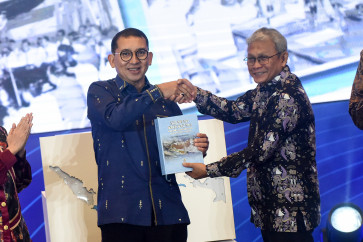Popular Reads
Top Results
Can't find what you're looking for?
View all search resultsPopular Reads
Top Results
Can't find what you're looking for?
View all search results#Kaburajadulu and the opportunities for a strategic talent policy
Singapore proactively scouts Indonesia’s top 1 percent talent such as winners of math or physics Olympics or other local competitions, enticing them with scholarships that lead toward permanent residency and finally naturalization.
Change text size
Gift Premium Articles
to Anyone
T
he recent ruckus about #KaburAjaDulu (“let’s just run away first”), which suggests moving abroad, in Indonesia’s social media has stirred much debate, awe and suspicion. From seeking higher income, gaining overseas work or study experience, to flexing on social media, the movement among Generation Z reflects a deeper desire to search for “something better”.
The #KaburAjaDulu movement is in fact not unique to Indonesia. In different labels or terms, it has happened in places such as India and Vietnam, as well as Africa and South America for decades. Silicon Valley, for example, is often a sweet spot for migration.
For countries experiencing a brain drain, or what some would call brain circulation, the #KaburAjaDulu phenomenon is a perfect time for nations to think about their talent policy. There is no consensus on what is meant by talent policy, but it is essentially a part of the broader policy framework to ensure a country’s labor competitiveness and national security.
After all, what makes up the economy are its people and their ability to manage the nation’s tangible and intangible resources for common prosperity. Imagine what would it be like if renowned artists, award-winning athletes, math and physics olympians or simply the best graduates in top schools were all to leave a country for greener pastures elsewhere. This is a sure loss for the country left behind. This can happen due to the absence of a talent policy.
There are a variety of tools at the disposal of policymakers to retain and attract talents in the country, ranging from right of abode, tax policy, scholarships, golden visas and many others.
In the United States, the H-1B visa is a powerful magnet to attract the best talent from around the globe. In fact, the US’ rise as a superpower since World War II has been driven largely by the migrants it has attracted and naturalized, until recently with Donald Trump’s anti-migrant stance.
Singapore’s permanent residency (PR) program is another example. The lion city proactively scouts Indonesia’s top 1 percent talent such as winners of math or physics Olympics or other local competitions, enticing them with scholarships that lead down a path toward PR and finally naturalization as citizens.
Key to this is selling the idea of meritocracy, a policy goal by nations like Singapore and the US to attract new migrants and talents, freeing talented people from their past baggage, whether racial, ethnic, religious or social class constraints.
It could also be tax policy that entices the best and most talented to come in. In the Netherlands, a 30-percent tax ruling for foreigners was implemented for many years to attract highly skilled workers, keeping the Dutch economy competitive. It also helps simplify complicated tax assessment systems for foreigners coming into the Netherlands.
Certainly, for countries that have “soft power”, for example, those known for speaking English, which is a lingua franca, such as the United Kingdom, Canada or Australia, there is little effort needed for talent policy.
In Hong Kong, its talent policy has attracted highly skilled new migrants and graduates from highly ranked universities worldwide, as part of the Greater Bay Area economic blueprint. Looking at the admissions statistics, Hong Kong has placed Indonesia as one of the main targets for master’s and doctoral-level scholarships.
You would not be surprised to find 25,000 French-speaking people in Hong Kong, dubbed the largest French society outside of France. Clearly, Hong Kong has a lot to offer, from a low tax regime, nil capital gains tax or inheritance tax and zero goods and services tax (GST) or value added tax. Clearly, many French folks are mathematically oriented, making them among the best to work in the banking and insurance industries, given Hong Kong’s status as a global hub for finance.
Not all talent policy is about attracting foreigners. It is also about sending domestic people overseas and having them return home to contribute. This offers emancipating opportunities for social and career mobility.
In Japan’s Meiji Restoration era circa 1868, thousands of young Japanese were sent overseas to study and many returned to rebuild the nation. In modern China, since the 1980s, the Chinese government has sent out tens of thousands of students, academics and scientists to study and gain experience overseas. The net effect of this talent policy is evident in China’s economic miracle and tech leadership.
Indonesia’s scholarships, such as the Endowment Fund for Education (LPDP), are actually a part of its national talent policy, yet it could be made more clear and strategic with a long-term view. Recent news reported that these scholarships, many of which are offered for master’s, doctoral and post-doctoral levels, are being cut. Instead, the scholarships should be deepened and enhanced by cutting down lower-priority policy items.
Dual nationality policy and long-term visas for Indonesian diaspora and their next generations have also disappeared from the national discourse; a relatively low-hanging fruit to bring talent back home.
Talent policy is a long-term game, looking toward a 10 to 100 year horizon for it to translate into outcomes. All these best practices from various countries offer some examples of policy tools at the disposal of policymakers for further debate and action.
***
The writer is an associate professor at the City University of Hong Kong, having studied, worked and lived in Australia, Singapore, the Netherlands and the United Kingdom. He can be reached at ychandra@cityu.edu.hk.











